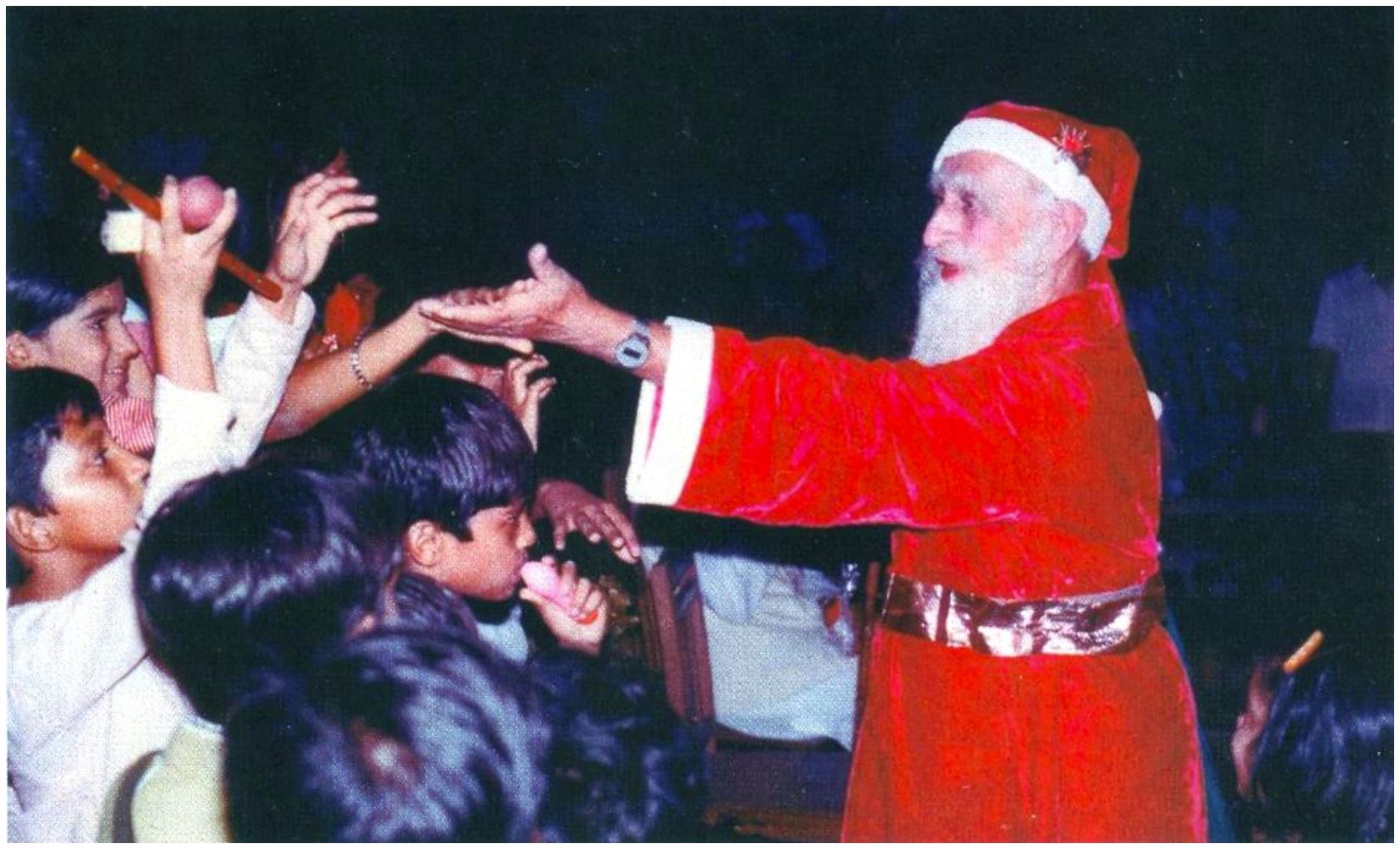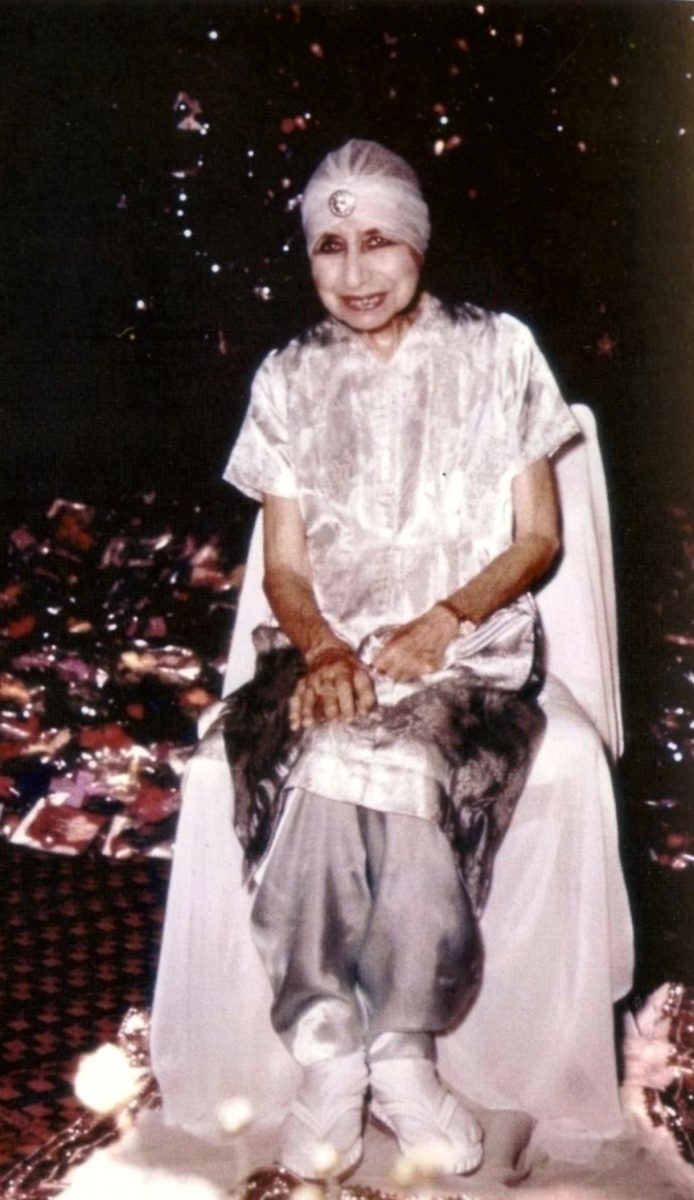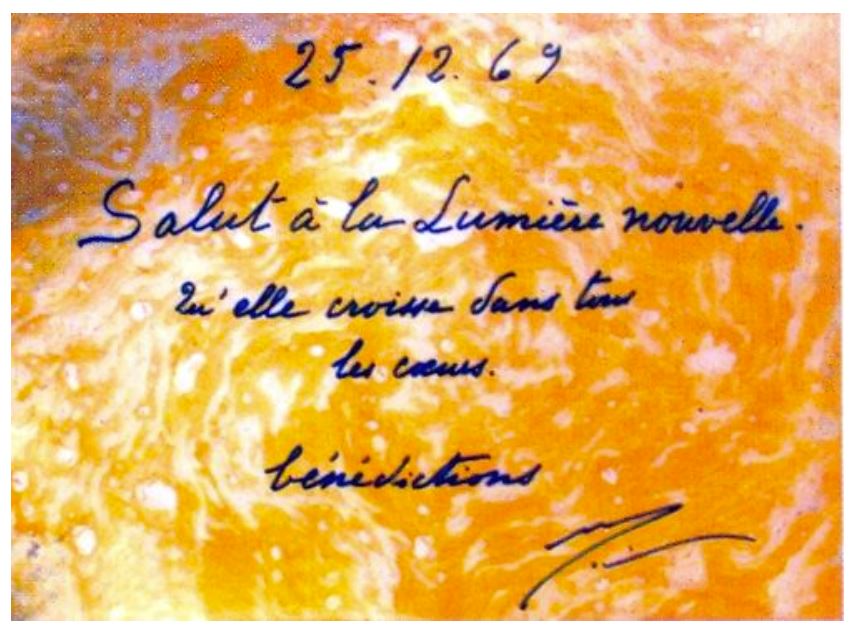 Many people often wonder about the origins of the Christmas celebrations in the Ashram. Of course, to those of us who grew up here, having seen the Christmas tree since our early childhood we have never given a thought about how it all started. We all remember how we would wake up to find a present on top of our mosquito-nets on the morning of the 25th December and how Udar-da would come in his red Father Christmas costume and a big white beard, ringing a bell. There would be a nip in the air. We would come to school and spend the whole morning listening to stories or visiting the various boardings of the School to see their Christmas decorations. We could hardly wait for it to be evening so that we could go to the Theatre where we had a lot of fun. There were presents, games and music. It was the only day during school time when the students did not have sports.
Many people often wonder about the origins of the Christmas celebrations in the Ashram. Of course, to those of us who grew up here, having seen the Christmas tree since our early childhood we have never given a thought about how it all started. We all remember how we would wake up to find a present on top of our mosquito-nets on the morning of the 25th December and how Udar-da would come in his red Father Christmas costume and a big white beard, ringing a bell. There would be a nip in the air. We would come to school and spend the whole morning listening to stories or visiting the various boardings of the School to see their Christmas decorations. We could hardly wait for it to be evening so that we could go to the Theatre where we had a lot of fun. There were presents, games and music. It was the only day during school time when the students did not have sports.
The earliest reference that we find of Christmas in the Ashram is in the reminiscences of Mrityunjoy Mukherji, but it is actually connected to another event in the Ashram. It was in 1929, on Christmas day, that Barindra Kumar, Sri Aurobindo’s younger brother left the Ashram. The Mother had organised a distribution of little bunches of the leaves she has called “New Birth” to mark that Christmas day. During the distribution Nolini-da noticed that Barindra Kumar was not present. Nolini-da then asked Mrityunjoy to go and see what had happened. When he went to the house where Barindra lived he did not see him anywhere. The next day Nolini-da and Amrita-da went to Barindra’s room and found a letter on the table. The letter informed them that he had left the Ashram. The fact that Barindra left on a Christmas day is highly significant.
One of the main reasons for his leaving the Ashram was his difficulty in accepting the Mother. He had been one of those who were deeply involved with the freedom movement and had even undergone rigorous imprisonment for ten long years in the Andaman Islands as one of the main accused in the Alipore Bomb Case. In his eyes the Mother was a European lady and her celebrating Christmas must have looked to him like glorifying the main festival of the British who were his enemies.
What he probably did not know was that the Mother was familiar with the ancient occult traditions of the West and was herself well-acquainted with the occult world. Long before Christmas came to be celebrated as the day of the birth of Christ there had been a festival which fell during the same week and was celebrated as the return of the Light to the Earth. It was in this spirit of remembering the new birth of Light that the Mother celebrated this day.
Historians today admit that the Christians superimposed their own festival on a day which was already a special day for the pagans. Astronomers now say that Christ was probably born in spring rather in the middle of winter and that he was most probably born three or four years before what is commonly accepted as the year of his birth. The scientists base their assumptions on the appearance of certain astronomical phenomena which happened around that period and in this way they have calculated a more realistic date of the birth of Christ.
Since in Pondicherry we live so close to the equator, we are used to seeing the sun rise and set almost at the same time throughout the year. We notice hardly a difference of half an hour between the time at which night falls in summer and the time at which this happens in winter. But to those who live closer to the Poles, for example in Europe, the lengthening and shortening of the days is a part of life. It is something that never fails to strike those who visit Europe for the first time to see how daylight lingers in the sky till ten o’clock at night in summer and how in winter it is night by four o’clock. On 21st December people observe the longest night of the year just as they celebrate the longest day of the year on June 21st.
Early man, all over the world, worshipped Nature. Those early people who lived in Europe must have observed how gradually the day got longer after the winter solstice. To them it must have been reason enough to rejoice, having lived through long, cold and grey days, to know that sunlight was going to return. A feeling of gratitude must have filled their hearts for that light which brought life, heat, flowers and fruits, and which made the earth alive once again. The very words “summer” and “sunshine” are almost synonymous with an inner warmth and cheerfulness in the English language. Even today in some Scandinavian countries people celebrate the festival of light with candles and special dinners.
We don’t have much information on how Christmas was celebrated in the 1930s in the Ashram. Maybe it wasn’t celebrated at all. However, when children started coming to the Ashram, the organisation of the daily life of the community took a new turn. Mona Pinto, being an Englishwoman, used to bake a special cake for the Mother and send her presents on 25th December after she joined the Ashram, because in her country it was a day of festivities and gathering of friends and families and also of exchanging of gifts as a symbol of love and affection. In 1944, during the war years, when all of a sudden, there was an influx of children the Mother asked Mona to organise a little celebration for them. The ladies who were working with Mona at Golconde made fancy hats and little presents. Games were organised and these presents were distributed. All this was done in the house opposite the Ashram Library where Mona used to live then with her husband Udar and their daughter Gauri.
The children enjoyed the celebrations so much that it was decided to hold it the following year too. A couple of years later the Pintos shifted to their house on Rue St. Gilles. The first year after they moved, the Christmas celebration was held there, but it was decided right there that from then on the distribution of the presents would be for everyone in the Ashram and that it would be more convenient if it were held at the Playground. For the next ten years or so the Christmas tree was decorated and lit up at the Playground. It was a simple affair, and the young and the old participated in the cheerful mood of the celebration. The Mother herself sat near the tree and distributed the presents.
In those days the Ashram’s finances were very limited so the presents which were given to the children were not new toys which were bought. What the children got in their little packets was mostly recycled material. The tennis balls with which the Mother played were afterwards passed on to the other players and when they were completely worn out they were dyed in bright colours and distributed to the children at Christmas. For many years the only things the children got were these brightly coloured balls and a top made at Harpagon, most probably from left-over bits of wood, and a few walnuts. The special presents were the objects people made themselves and offered to the Mother on their birthdays. These beautiful things were sent to Mona to keep in her store and brought out at Christmas and given as presents. Many years later Manoranjan-da would go to Madras and buy little plastic toys. Even though everyone enjoyed this little celebration, the Playground, as it turned out, was not the ideal place. Sometimes it rained and everything had to be hurriedly taken into one of the rooms. At other times there was a strong wind and the decorations on the tree  would get blown away.
would get blown away.
In 1956 the Theatre Hall was constructed and was at that time the largest covered space of the Ashram, and perhaps it still is. From 1958 the Christmas tree was decorated at the Theatre and the Mother distributed the gifts there. Mona sat next to her, and one by one, handed her the packets to be given. Since then the celebrations have been held there, except for a couple of years in the seventies when the tree was brought to the School. This was because firstly, the Ashram had some financial constraints and secondly, during the Indo-Pak war the Ashram wanted to show its solidarity with the country and decided to keep things to an austere minimum.
Probably the last time that the Mother came to the Theatre for the Christmas distribution was in 1961. That year she did not sit and distribute the presents but only came and saw the decorations. It seems that that year she only distributed the packets to a few people and left. When the Mother stopped coming to the Theatre the distribution was done by Mona. On many occasions Mona said that had the Mother herself not insisted on this celebration she would not have done any of this planning and packing and counting and sorting, as it meant a lot of work for her and her team all through the year. But she did it with all her enthusiasm and all her cheerfulness because it was for the Mother.
At the beginning Mona would collect little things which she thought could make good presents, as and when she received them, and would keep them separately in a cupboard. Over the years the preparations for the Christmas distributions became more and more organised. As Mona was in charge of this distribution all the preparation and storing of the presents was done in the basement of Golconde, and is still being done there. Several people work all through the year to collect and sort things which eventually go into the packets which are distributed. Some things are made and some things come as donations in kind. Little objects are divided into different lots,depending on which age groups they might be suitable for. Some presents are bought with the money that is donated by well-wishers to the Christmas fund.
From 1959 until 1972 the Mother gave messages for Christmas which were put up on the Ashram notice-board along with a collection of beautiful cards. Those messages are a real indicator of the spirit in which this celebration was done. In all the messages the Mother refers to the day as “Noel” and speaks of the Light, of renewal and peace. Even though all over the world Christmas has become one big shopping season, we in the Ashram have had the privilege of knowing its ancient and occult significance. And it was with this idea of invoking the Light that the Mother had started this tradition in the Ashram.

A card with The Mother’s Message of 1969
[The above text is written by Sunayana Panda and originally appeared at the website http://savitri.in ]




